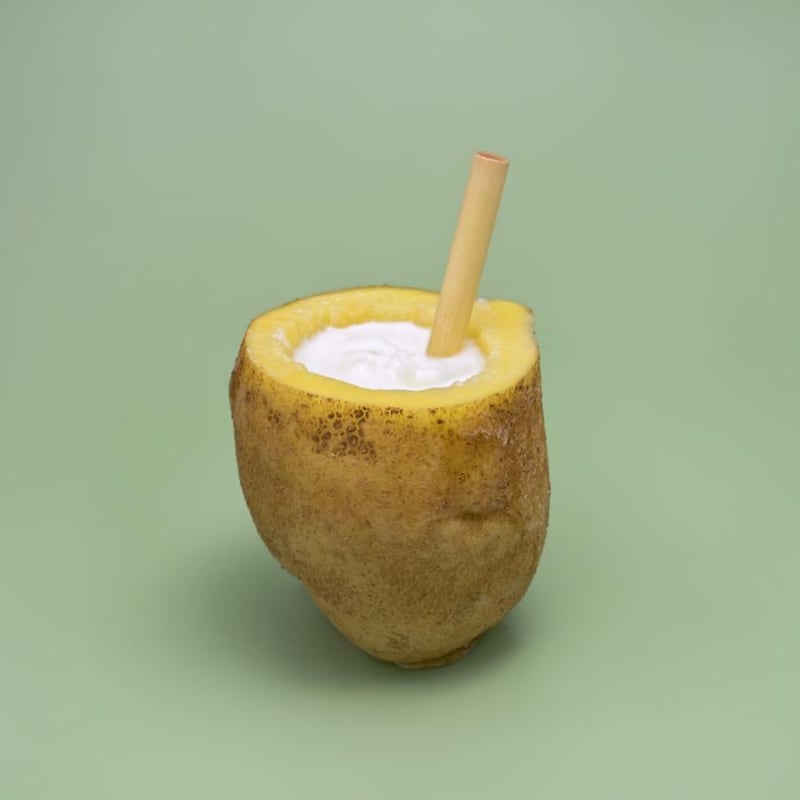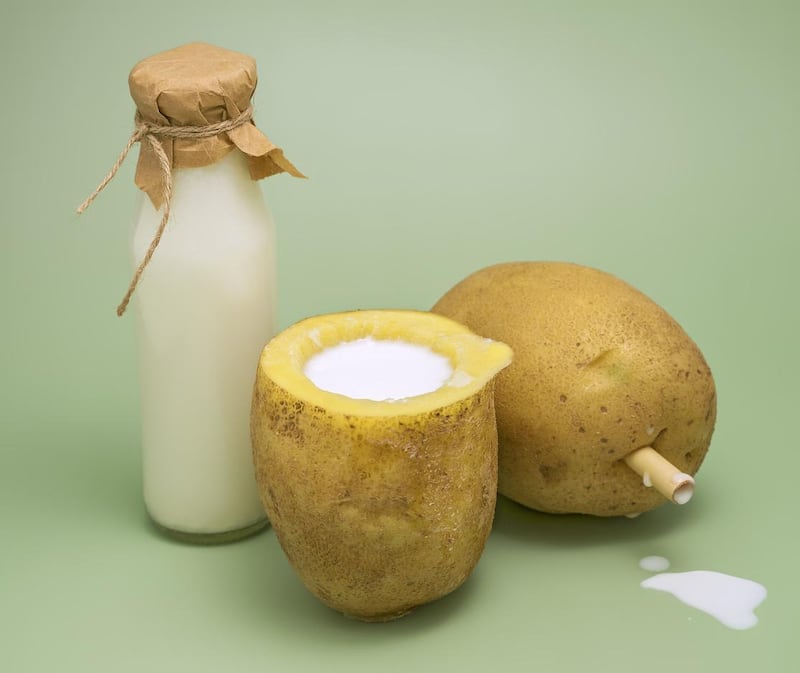It is a bountiful time for plant-based milks, with new varieties of nut, seed, grain, legume and now vegetable milks showing up on store shelves every year. Now comes potato milk.
The product, made by the Swedish company Dug Drinks, is already being sold in the UK and will make its way to Ireland later this year. And according to a new report released by Waitrose, potato milk is "set to dominate coffee shop menus in the coming months" – however unlikely that may sound.
In August, Sarah Bentley (40) heard about Dug and its potato milk. Bentley, who lives in London and runs the plant-based-cooking school Made In Hackney, was immediately interested.
“I was definitely excited, as it was new, but it doesn’t naturally sound appetizing,” she said. “You imagine gunky potato water, which of course would be gross.” Bentley and some of her cooking-school colleagues tried to make their own potato milk, with disappointing results. “It wasn’t very delicious, but I’m definitely keen for a rematch, as I can see its potential. The more viable alternatives to mass-produced dairy, the better.”
Bentley is far from alone in that sentiment. During the past decade, interest in the health, environmental and ethical benefits of a vegetarian or vegan diet has helped spawn a proliferation of milk substitutes. The aisles of grocery stores and the counters of coffee shops are populated with milks made from oats, almonds, cashews, macadamia nuts, hemp seeds, sesame seeds, peas and flaxseeds.
You might think we have reached peak plant milk, but you would be wrong.
"I don't think there is an end in sight for dairy alternative innovation – or at least not anytime soon," said Sydney Olson, a food and drink analyst for Mintel, an international market research firm.

Plant-based foods are “a really hot topic at the moment,” said David Julian McClements, a professor at the University of Massachusetts Amherst. He has worked as a food scientist for more than 20 years, but in the past five his research has focused entirely on plant-based foods, he said, “because that is one of the main trends in the food industry at the moment for sustainability, ethical and health reasons”.
Irregular shopping habits that began during the pandemic, with panic buying and supply-chain issues, have also pushed more people to buy plant-based milk, said Denise Purcell, vice president of content and education for the Specialty Foods Association, and an in-house expert on trends.
“The shelves were empty, and people were stocking up because they knew they were going to be at home, and it was an opportunity if they couldn’t get their regular milk product,” Purcell said. “It was sort of like a gateway. They would try it, and it would lead them to try other products.”
The pandemic has also led more people to cook at home, using both dairy and plant milks. But Olson, the food and drink analyst, said that while sales of dairy milk are expected to return to a pre-pandemic trajectory of decline, nondairy milk will continue to ride the surge of interest in plant-based diets.
Plant milk sales in the United States totalled $2.5 billion (€2.2 billion) at the end of 2020, accounting for 15 per cent of all retail sales of milk, and 35 per cent of the larger market for plant-based foods. By the end of 2026, Olson said, sales of dairy alternatives are projected to make up 30 per cent of all milk sales. Much of that growth, Purcell said, will come from small-batch producers.
Plant milks have existed for centuries in cultures worldwide. Horchata, a creamy beverage made with ground tiger nuts (a kind of tuber), originated in North Africa a millennium ago, and it has become popular in Spain and Latin America. Coconut milk, made from the liquid of grated coconut meat, has been used for centuries in South Asia, South America and the Caribbean.
'Living in a metropolitan hub like London, I have no need to be drinking cow, goat or any other animal's milk'
Native Americans, especially in the northeastern United States, have used nuts to make nut butter and milk for infants. Almond milk has been a staple ingredient in North Africa, Europe and the Middle East for nearly 1,000 years. As almond milk was becoming popular in Europe, soy milk use was growing in China – and by the 1970s and 1980s, soy milk could be found in health food stores throughout Western nations.
Today, many milks are made by soaking, grinding, pressing or blending the nut, seed or vegetable into a slurry that is then strained and sometimes mixed with oils or other ingredients that help emulsify it for a creamier texture. Because the process makes liquid from a wide array of plant sources, the number of blends and varieties of nondairy milk is nearly limitless.
While plant-based milks may seem to guarantee a healthier alternative to cow's milk, some may contain added sugars, be ultra-processed or lack the same nutrients as cow's milk. The dairy industry and some members of Congress have been pushing the US Food and Drug Administration to prohibit the labelling of plant-based products as "milk".
Some highly processed plant-based milks can also have a negative impact on the environment. Most ingredients used in plant milks are associated with a lower carbon footprint than those in dairy milk.
But many, especially nuts and coconuts, pose their own environmental problems. Almonds are typically grown in areas suffering from water scarcity, and increased demand for them is depleting the water supply in those communities. Rising demand for coconut is leading to increased cultivation and the potential for deforestation and the loss of biodiversity.
While almond and oat milk may be the most popular plant milks on the market today, blends that combine assorted nuts, seeds, grains, legumes and more are an emerging innovation, Olson said. She said the blends were aimed at consumers who are not necessarily vegan, and who might avoid plant milk because of its taste or because they can’t cook with it.

Vegetable-based milks are less common. In 2015, Veggemo introduced a blended milk in Canada made from pea protein, cassava root and potato starch. Since 2016, the vegan food brand Ripple has used pea protein as a base for its milk. At the Specialty Food Association's trade show in February, new plant milks on display included oat milk made with mushrooms, banana milks and even cheese made from carrots.
But for many people, cow’s milk is still the standard for taste, and companies are always tweaking their products to be more similar to the dairy products that most Americans are used to, McClements said.
“That’s often challenging,” he added, “because obviously plant ingredients are very different from animal ingredients. I think we definitely will see improvements in the future. It’s still quite early.”
As novelty wears off and familiarity increases, consumers are more critically evaluating their plant-based choices, Olson said. “Expectations are rising, and brands can’t afford to be reliant on plant-based claims alone.”
She said shoppers can expect to see more plant-based milk brands addressing concerns about overprocessing on their labels – highlighting minimal and natural ingredients, and focusing on benefits like high protein and high vitamin and mineral content.
Bentley, who runs the London cooking school, said she chooses plant milk over cow’s milk for ethical, health and sustainability reasons. She prefers hemp milk for its low environmental impact, and oat milk that is enriched with B and D vitamins for her son.
"Living in a metropolitan hub like London, I have no need to be drinking cow, goat or any other animal's milk," she said. "For people sourcing their food from the industrialised food system, plant milk is the way to go. No question." – This article originally appeared in The New York Times





















